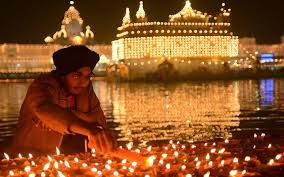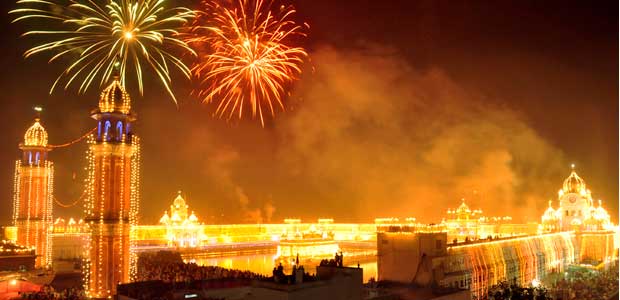Diwali – The Festival Of Light
We all celebrate Diwali. But do we all know all the background? Where does it derive from? What does it mean and stand for? We want to give a little update on Diwali or Deepawali, as one also calls it.
The great festival of light signifies triumph of light over darkness, good over evil, knowledge over unawareness and optimism over pessimism. ‘Deepwali’ is a combination of two Sanskrit words ‘Dipa’ and ‘Avali’. ‘Dipa’ means ‘light’ or ‘lamp’ and ‘Avali’ means ‘row’ or ‘series’. Hence, the word’ Deepawali’ means ‘a row or series of light’. Deepawali celebration observes lighting ‘diyas’ (lamps made up of earth and filled with oil) in and around houses, temples and other buildings where it is celebrated. According to Hindu calendar, Diwali falls on the new moon night (Amavasya night) which is also the end of Hindu lunar month ‘Ashwin’ and the beginning of month ‘Kartik’.
Diwali is celebrated by Hindus, Sikhs and Jains to mark various historical events. Apart from India, it is also celebrated in Nepal, Sri Lanka, Pakistan, the United States, United Arab Emirates, Myanmar, Thailand, the United Kingdom, Malaysia, Singapore, the Netherlands, Canada, Indonesia, Australia, New Zealand, Fiji, Mauritius, Kenya, Tanzania, South Africa, Trinidad and Tobago, Guyana and Suriname. In most parts of India, Diwali is a five day celebration. It begins with ‘Dhanteras’ that falls two days before the main night. Dhanteras is followed by ‘Narka Chaturdasi’ popularly called as ‘Chhoti Diwali’ (Small Diwali). After this, comes the main Diwali Night or ‘Lakshmi Puja’. The day after Diwali is celebrated as ‘Padwa’ and finally it ends with ‘Bhai Dooj’
Significance Of Diwali In Hinduism
Hindus celebrate Diwali as the return of God Ram, his wife seeta and his brother Lakshman after the end of fourteen long years of exile. This incidence is marked in the Hindu epic ‘Ramayana’. It is believed that when God Ram returned to Ayodhya with Seeta and Lakshman, the people of Ayodhya lit ‘diyas’ or ‘deep’ in series on the roofs of the houses, corridors and on the entrances to welcome them. Some people also see Diwali as the return of the ‘Pandavas’ after thirteen years of ‘Vanvas’ (living in the forests) including one year of Agyatvas (A period when ones identity must not be revealed) as mentioned in the epic ‘Mahabharata’.
According to another very popular belief, Goddess Lakshmi (the Goddess of wealth and prosperity was born on the first day of Diwali when ocean of milk was churned by gods and demons. Goddess Lakshmi married Lord Vishnu on the main Diwali night. Hindus worship Goddess Lakshmi along with Lord Ganesha on the main Diwali night. Sikhs celebrate Diwali as the day when Guru Har Gobind set himself free from the prison of Islamic King Jahangir and reached Golden Temple in Amritsar. Based on this belief the Sikhs celebrate Diwali by lighting up the temple, burning crackers and other festivities. Jains celebrate Diwali in remembrance of Mahavira. According to Kalpasutra, Mahavira attained Nirvana on this day which marked presence of many gods that illuminated the darkness.
Dhanteras
The first day of Diwali is celebrated as Dhanteras. Before Dhanteras, the houses and all commercial places are cleaned and decorated. Rangoli (Colourful patterns on floor) is made inside and on entrance of homes, shops, offices etc. Since this day marks the birth of Goddess Laksmi, buying household goods, utensils, jewellery or other items that symbolizes Lakshmi is considered auspicious by people. People lit diyas to welcome goddess Lakshmi and at many places the diyas are kept burning all night long. Dhanteras is a major shopping day for Indian people. Markets are filled with special arrangements for Dhanteras. Buying gold and silver is considered very auspicious and this is why jewellery shops are flooded with new designs, attractive offers and special silver coins with Ganesha and Lakshmi embedded in them.
Naraka Chaturdasi or Chhoti Diwali
The second day is called Naraka Chaturdasi or Chhoti Diwali. Some people choose to make rangoli on this day instead of Dhanteras. In some regions of India, a fragrant oil bath is held which is followed by minor worshipping rituals. This day also observes lighting of diyas and burning of crackers. People spend the day shopping and preparing for the main night.
Lakshmi Puja
The third day, the main Diwali night is celebrated as Lakshmi Puja. People wear new clothes, make rangoli in and around houses, offices, shops, temples etc, worship goddess Lakshmi, lit the houses with diyas, candles and modern lighting items, visit friends and relatives, share gifts, eat sweets and burn crackers. It is believed that goddess Lakshmi climbs down to earth on Diwali night. Lord Ganesha is also worshipped along with goddess Lakshmi as he symbolizes ethical beginnings for Hindus. In many parts of India, goddess Saraswati (the goddess of knowledge, wisdom and music) and Kubera (symbol of treasury management and book keeping) is also worshipped along with Lakshmi and Ganesha. This day is also marked as the ‘New Year’ day according to Vikram Samvat Calender. Businessmen view this day as the new fiscal year and make a new start with blessings of goddess Lakshmi.
In many parts of the country, ‘Melas’ (Fun Fairs) are organised. People can shop, eat various types of sweets, cuisines and enjoy fun rides and shows in these melas. In the Eastern regions, the main Diwali night is celebrated as ‘Kali Puja’ instead of ‘Lakshmi Puja’ where goddess Kali is worshipped. In North Central regions, Lord Krishna is worshipped on this day. In some regions, a feast is held on this day which is known as ‘Annakoot’. For Annakoot, fifty six or one hundred eight different dishes are prepared and offerings are made to Lord Krishna. The cuisines are then shared by the local community.
Padwa
Padwa celebrates the love and devotion between a husband and wife. Wives are given gifts by their husbands and newly married couples are invited for special meals by the bride’s family. Brothers visit their sisters In Law’s home and bring them to their mother’s home to celebrate Padwa and Bhai Dooj that falls a day after Padwa.
Bhai Dooj
Bhai Dooj or Govardhan Puja celebrates the love between a brother and a sister. In many regions, sisters keep a fast and pray to god to bestow happiness, prosperity and a long life to their brothers. Different regions see various rituals for this day but all of them symbolize the love between siblings. With Bhai Dooj the five day of celebration comes to an end.
Modern Era Diwali
With changing times, Diwali has also seen lots of change. While in olden days people preferred to lit their houses with earthen lamps filled with oils, modern lighting items such as series bulbs, glass candles, artificial electrical diyas etc. have replaced the traditional earthen diyas now. People spend lavishly on decorating their houses with various modern lights. Some people also concentrate more on burning expensive fireworks to show off their wealth and status instead of participating in the other traditional rituals. Diwali brings lots of joy and is one of the most sacred festivals of India. On the other hand, it is also one of the most contributing factor in growing air pollution and noise pollution in India. It is high time India and other countries found ways to celebrate eco-friendly Diwali so that the real meaning and joy of this grand festival is maintained.












